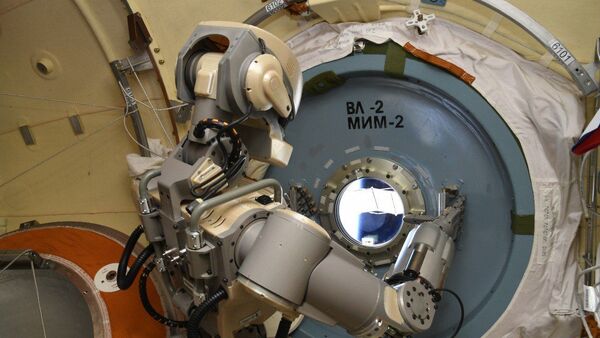The Fedor robot is likely to be just the first step to a whole army of Russian robot cosmonauts sent to space to carry out a wide array of missions, Yevgeny Dudrov, executive director of Androidnaya Tekhnika, the company which developed the robot, has said.
“It’s premature to speak about what kind of detachment [of robots] this will be and what tasks they will carry out, because we are now still at the stage of defining our objectives,” Dudrov noted.
According to the developer, the next step will require analysing the results of the Fedor experiment, and defining the tasks which robots could possibly help with, from conducting repair work on the exterior of the ISS, to the repair of satellites, to working as robot colonisers on the moon.
“All of this will have to be placed on a kind of ‘road map’ and we will have to determine what kinds of robots we need to complete it, whether they be anthropomorphic, non-anthropomorphic, [i.e. with non-human characteristics], robot manipulators,” etc, Dudrov said.
According to the director, although his company believes in the concept of using anthropomorphic robots on the ISS and the Moon, this is not a dogmatic view. “Most likely, a whole series of devices will appear, each of them refined toward their own respective task,” he said.
As for Fedor, the humanoid robot designed to operate in ‘avatar’ mode via a human operator, but who is also capable of completing various preprogrammed tasks, he will remain the first space pioneer of his kind for the history books.
Луна, Марс... Для покорения планет Солнечной системы должны быть созданы колонии роботов-аватаров. Роботы готовы дать свои предложения по техническому облику будущей антропоморфной системы, способной обеспечить развёртывание и обслуживание научных станций в далёком космосе pic.twitter.com/b5Lxqev568
— FEDOR (@FEDOR37516789) September 18, 2019
Tweet, from Fedor's official Twitter account, reads: "The Moon, Mars...To harness the planets of the solar system, colonies of robot avatars must be created. Robots are prepared to give their suggestions on the technical appearance of the future anthropomorphic systems which will be capable of ensuring the deployment and maintenance of scientific stations in the far reaches of space."
Fedor touched down in Kazakhstan in a lander capsule earlier this month after completing his flight test programme. The robot’s mission to the ISS got off to a rocky start in August after the Soyuz MS-14 spacecraft carrying him failed to dock with the ISS due to a docking module fault, with the craft retreating to a safe distance away from the space station before making a second, successful attempt to dock after several days.
During his time onboard the ISS, after overcoming some technical problems, Russian cosmonauts began experimenting with Fedor, simulating repairs to the exterior of the station in avatar mode, having him joining electrical connectors, and working with various tools.

